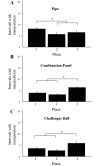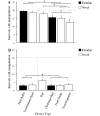Assessment of foraging devices as a model for decision-making in nonhuman primate environmental enrichment
- PMID: 25255067
- PMCID: PMC4181686
Assessment of foraging devices as a model for decision-making in nonhuman primate environmental enrichment
Abstract
Continued progress to move evidence-based best practices into community and regulatory animal welfare standards depends in part on developing common metrics to assess cost, benefit, and relative value. Here we describe a model approach to evidence-based evaluation and an example of comprehensive cost-benefit assessment for a common element of environmental enrichment plans for laboratory-housed nonhuman primates. Foraging devices encourage a species-typical activity that dominates the time budget of primates outside captivity and provide inherent cognitive challenges, physical activity demands, and multi-sensory stimulation. However, their implementation is not standard, and is challenged by perception of high costs and labor; nutritional and health concerns; and identification of best practices in implementation (that is, device types, food type, frequency of delivery and rotation). To address these issues, we directly compared monkeys' engagement with different foraging devices and the comprehensive cost of implementing foraging opportunities. We recorded 14 adult male cynomolgus monkeys' interactions with 7 types of devices filled with a range of enrichment foods. All devices elicited foraging behavior, but there were significant differences among them both initially and over subsequent observations. Devices that afforded opportunity for extraction of small food items and that posed manipulative challenge elicited greater manipulation. The cost of providing a foraging opportunity to a single monkey is roughly US$1, with approximately 80% attributable to labor. This study is the first to perform a rigorous cost-benefit analysis and comparison of common foraging devices included in environmental enrichment. Its broader significance lies in its contribution to the development of methods to facilitate improvement in evidence-based practices and common standards to enhance laboratory animal welfare.
Figures






References
-
- Baker KC, Weed JL, Crockett CM, Bloomsmith MA. 2007. Survey of environmental enhancement programs for laboratory primates. Am J Primatol 69:377–394 - PubMed
-
- Bayne K, Dexter S, Mainzer H, McCully C, Cambpell G, Yamada F. 1992. The use of artificial turf as a foraging substrate for individually housed rhesus monkeys (Macaca mulatta). Anim Welf 1:39–53
-
- Bayne KA, Hurst JK, Dexter SL. 1992. Evaluation of the preference to and behavioral effects of an enriched environment on male rhesus monkeys. Lab Anim Sci 42:38–45 - PubMed
-
- Benefiel AC, Dong WK, Greenough WT. 2005. Mandatory ‘enriched’ housing of laboratory animals: the need for evidence-based evaluation. ILAR J 46:95–105 - PubMed
Publication types
MeSH terms
Grants and funding
LinkOut - more resources
Full Text Sources
